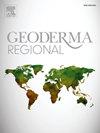Biosolids-derived phosphorus persists in Florida sandy soils
IF 3.3
2区 农林科学
Q2 SOIL SCIENCE
引用次数: 0
Abstract
Biosolids, the solid byproduct from sewage treatment plants, are utilized as soil conditioners and fertilizers due to their rich organic matter and nutrient content. However, there are concerns about heavy metals and high levels of phosphorus in biosolids which can lead to environmental issues such as increased biotoxicity and eutrophication of water bodies. This study examines the effects of historical biosolids applications on sandy soils at a former ranch in Seminole County, Florida, focusing on the persistence of legacy phosphorus and heavy metals 14-years post-application. Our results showed that concentrations of heavy metals such as chromium, copper, nickel, lead, and zinc in the top 15 cm of soil were well below the Environmental Protection Agency and European Union recommended limits, indicating no significant long-term accumulation. In contrast, phosphorus levels were notably higher in biosolids-treated soils compared to untreated samples, demonstrating the persistence of legacy phosphorus and raising concerns about potential eutrophication in water bodies. Examination of the vertical movement of biosolids-derived materials revealed elevated phosphorus and calcium levels in both topsoil and subsoil horizons, suggesting that phosphorus was translocating with calcium. These findings highlight the persistent residual effects of legacy phosphorus, evident even in sandy, leachable soils 14 years post-application, suggesting that legacy phosphorus may have a longer half-life than currently assumed and that its role in long-term biosolids application projects could be underestimated.
生物固体衍生的磷持续存在于佛罗里达州的沙质土壤中
生物固体是污水处理厂的固体副产品,由于其丰富的有机物和营养成分,被用作土壤调节剂和肥料。然而,人们对生物固体中的重金属和高磷含量表示关切,这可能导致诸如生物毒性增加和水体富营养化等环境问题。本研究考察了在佛罗里达州塞米诺尔县一个前牧场施用生物固体对沙质土壤的影响,重点研究了施用14年后遗留磷和重金属的持久性。我们的研究结果显示,土壤表层15厘米的重金属,如铬、铜、镍、铅和锌的浓度远低于环境保护署和欧盟建议的限值,表明没有显著的长期积累。相比之下,经过生物固体处理的土壤中的磷含量明显高于未经处理的样品,这表明遗留磷的持久性,并引起了对水体潜在富营养化的担忧。对生物固体衍生物质的垂直运动的检查显示,表层土壤和底土层的磷和钙水平均有所升高,这表明磷随钙转运。这些发现强调了遗留磷的持续残留效应,即使在施用14年后的沙质可浸土壤中也很明显,这表明遗留磷的半衰期可能比目前假设的要长,并且其在长期生物固体施用项目中的作用可能被低估了。
本文章由计算机程序翻译,如有差异,请以英文原文为准。
求助全文
约1分钟内获得全文
求助全文
来源期刊

Geoderma Regional
Agricultural and Biological Sciences-Soil Science
CiteScore
6.10
自引率
7.30%
发文量
122
审稿时长
76 days
期刊介绍:
Global issues require studies and solutions on national and regional levels. Geoderma Regional focuses on studies that increase understanding and advance our scientific knowledge of soils in all regions of the world. The journal embraces every aspect of soil science and welcomes reviews of regional progress.
 求助内容:
求助内容: 应助结果提醒方式:
应助结果提醒方式:


